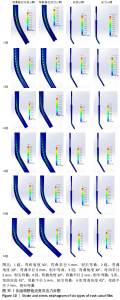[1] 邓菲菲.两种新型镍钛锉在弯曲根管预备时的根管偏移[J].医疗装备,2018, 31(3):126-127.
[2] 钱才梅,李泽汉,闫明.M3机用镍钛器械预备中度弯曲根管的临床分析[J].南京医科大学学报(自然科学版),2017,37(12):1678-1680.
[3] 何莉君,漆小娟,王月婷.机用ProTaper镍钛锉在磨才根管治疗中的临床研究[J].成都医学院学报,2016,11(5):609-612.
[4] 关卿,金涛,顾永春,等.3种根管预备器械在弯曲根管中扭转负载下的三维有限元分析[J].国际口腔医学杂志,2015,42(3):269-272.
[5] 袁理,白雪岭,李飒,等.3种机用镍钛锉根管预备对上颌第一磨牙应力的影响[J].口腔疾病防治,2018,26(7):445-450.
[6] SANTOS AL, BAHI MG, DE ELC, et al.Comparison of the mechanical behavior between controlled memory and superelastic nickeltitaniumfiles via finite element analysis. J Endod. 2013;39(11):1444-1447.
[7] MONTALVAO D, ALCADA FS, BRAZ FM, et al. Structural characterizationand mechanical FE analysis of conventional and M-Wire Ni -Tialloys usedin endodontic rotary instruments. Sci World J. 2014;2014:1-8.
[8] MONTALVAO D, ALCADA FS. Numeric compari sonof the stat ic mechanicalbehavior between ProFile GT and ProFile GT series X rotary nickel-titanium files. J Endod. 2011;37(8):1158-1161.
[9] 黄宇文.有限元分析在口腔生物力学中的应用[J].中国组织工程研究,2012, 16(13):2423-2426.
[10] ELNAGHY AM, ELSAKA SE, MANDORAH AO. In vitro comparison of cyclic fatigue resistance of TruNatomy in single and double curvature canals compared with different nickel-titanium rotary instruments. BMC Oral Health. 2020;20(1):38.
[11] ZUBIZARRETA-MACHO Á, MENA ÁLVAREZ J, ALBALADEJO MARTÍNEZ A, et al. Influence of the Pecking Motion Frequency on the Cyclic Fatigue Resistance of Endodontic Rotary Files. J Clin Med. 2019;9(1):45.
[12] 陈君,岳林,王嘉德,等.根管扩大程度与牙根强度和应力分布的关系[J].中华口腔医学杂志,2006(11):661-663.
[13] 付宏宇,王芳芳,侯晓攻.控制记忆合金丝镍钛根管锉弯曲性能有限元分析模型的构建及力学分析[J].北京大学学报(医学版),2019,51(1):131-135.
[14] NAGI SE, KHAN FR, RAHMAN M. Comparison of fracture and deformation in the rotary endodontic instruments: Protaper versus K-3 system. J Pak Med Assoc. 2016;66(Suppl 3)(10):S30-S32.
[15] DRUKTEINIS S, PECIULIENE V, DUMMER PMH, et al. Shaping ability of BioRace, ProTaper NEXT and Genius nickel-titanium instruments in curved canals of mandibular molars: a MicroCT study. Int Endod J. 2019;52:86-93.
[16] KABIL E, KATIĆ M, ANIĆ I, et al. Micro-computed Evaluation of Canal Transportation and Centering Ability of 5 Rotary and Reciprocating Systems with Different Metallurgical Properties and Surface Treatments in Curved Root Canals. J Endod. 2021;47:477-484.
[17] GLUSKIN AH, BROWN DC, BUCHANAN LS. A reconstructed computerized tomographic comparison of Ni-Ti rotary GT files versus traditional instruments in canals shaped by novice operators. Int Endod J. 2001;34:476-484.
[18] TAVARES KIMC, PINTO JC, SANTOS-JUNIOR AO, et al. Combination of a new ultrasonic tip with rotary systems for the preparation of flattened root canals. Restor Dent Endod. 2021;46:e56.
[19] PIVOTO-JOÃO MMB, TANOMARU-FILHO M, PINTO JC, et al. Root Canal Preparation and Enlargement Using Thermally Treated Nickel-Titanium Rotary Systems in Curved Canals. J Endod. 2020;46(11):1758-1765.
|



